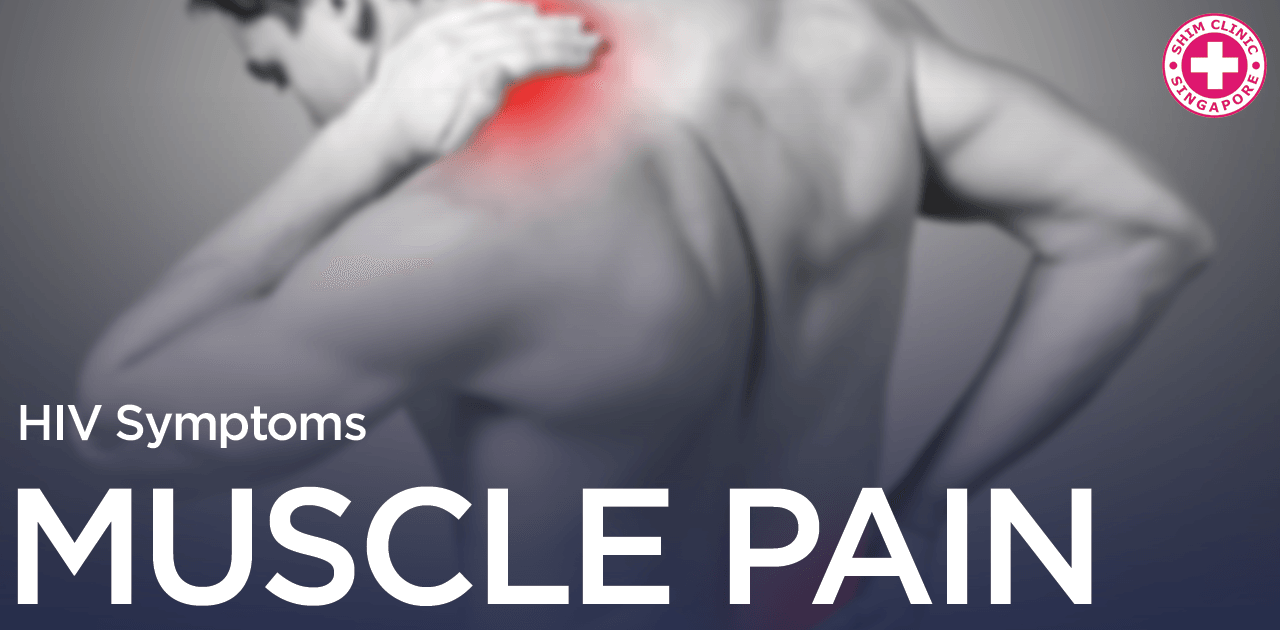HIV Muscle Pain Singapore | Shim Clinic
| Help me about HIV Muscle Pain ! |

| Permalink: https://shimclinic.sg/hiv-muscle-pain |
Acute HIV infection can cause symptoms of illness, but then the virus will cause no symptoms for years. These symptoms, which may include fever, rash, and muscle aches, go away after a few weeks, but the virus isn’t gone. It’s important to get an HIV test so you can get treatment for HIV.
Many people who have an HIV infection don’t know that they have it, because the virus can remain in the body for years without causing symptoms. However, there are some clues that you may have acquired HIV. Some people experience an illness known as acute HIV infection (sometimes called primary HIV infection or seroconversion illness) when they first get the virus. If there are symptoms of this, they begin two to four weeks after the exposure, and then can last for several weeks before getting better on their own. After the symptoms disappear, the virus isn’t gone; it’s still in the body, but won’t cause any more symptoms for years.
The symptoms of acute HIV infection are generalized symptoms of illness and are frequently attributed to something else, such as a common cold or flu. One of these symptoms is myalgia, which is the medical term for muscle pain. Although there may be a muscle ache in just one muscle, it’s more common to have more broad muscle discomfort, which can affect many parts of the body. It may feel similar to the muscle soreness that you feel after a hard workout, or when you sleep in a strange position and feel stiff and sore the next morning. However, the muscle pain from the infection won’t go away after a day or two (as these other causes of muscle aches do), but will linger, often for weeks. Anti-inflammatory medication may help, but only temporarily.
- Acute HIV infection can cause symptoms of illness, but then the virus will cause no symptoms for years.
- Myalgia, or muscle pain, is a common symptom of acute HIV infection.
- Myalgia and other HIV symptoms will begin 2 to 4 weeks after the exposure, then continue for several weeks before getting better.
- Other causes of muscle aches are also common, so it’s necessary to have an HIV test to diagnose the infection.
- Visit an STD clinic to get a confidential HIV test and consult with an expert about your possible HIV symptoms.
Muscle aches can also be a symptom of other types of viral infection. For example, it’s common to have myalgia when you have influenza (“the flu”). There are also other possible causes of muscle aches, including injuries and diseases like fibromaylgia. The muscle aches themselves don’t have any special characteristics that let you know that HIV is causing them. You’ll need to have an HIV test to determine whether HIV is what’s causing your illness.
You can go to an STD clinic to get a confidential HIV test. Be sure to tell the doctor about any symptoms you may be experiencing, because they could be HIV symptoms. In addition, you should tell the doctor about any possible HIV exposure you may have had, so you can get the right HIV test. Many types of rapid HIV test will not become positive until 3 to 12 weeks following the exposure, so they most likely won’t be positive during an acute HIV infection. You’ll need the right type of HIV test to detect the infection. Detecting HIV early allows you to receive treatment before the virus causes severe symptoms.
Sources:
Mayo Clinic. “STD symptoms: Common STDs and their symptoms.” Mayo Clinic. Published 18 Mar 2015. Accessed 20 Jul 2016. http://www.mayoclinic.org/std-symptoms/art-20047081
Centers for Disease Control and Prevention. “Screening Recommendations Referenced in Treatment Guidelines and Original Recommendation Sources.” Centers for Disease Control and Prevention. Published 04 Jun 2015. Accessed 20 Jul 2016. http://www.cdc.gov/std/tg2015/screening-recommendations.htm
Centers for Disease Control and Prevention. “HIV/AIDS.” Centers for Disease Control and Prevention. Published 05 Jul 2016. Accessed 27 Jul 2016. http://www.cdc.gov/hiv/
Centers for Disease Control and Prevention. “HIV Basics – Testing.” Centers for Disease Control and Prevention. Published 12 Jul 2016. Accessed 20 Jul 2016. http://www.cdc.gov/hiv/basics/testing.html
U.S. Department of Health & Human Services. “Post-Exposure Prophylaxis (PEP).” AIDS.gov. Published 21 Sep 2015. Accessed 20 Jul 2016. https://www.aids.gov/hiv-aids-basics/prevention/reduce-your-risk/post-exposure-prophylaxis/
| Timeline | HIV | STD | Pregnancy |
|---|---|---|---|
| Before exposure | |||
| Contraception (females only) | |||
| HIV PrEP (pre-exposure prophylaxis) - Stop HIV infection before exposure | STD vaccine: - Hepatitis vaccine - HPV vaccine | ||
| STD / HIV exposure | |||
| 0-72 hours | HIV PEP (post-exposure prophylaxis) - Stop HIV infection after exposure | STD testing * - Screening test - to look for asymptomatic infections - from previous exposures | Emergency contraception with the morning-after pill (females only) |
| 2 weeks | HIV DNA Test | ||
| 1 month | HIV 4th Generation Test - SD Bioline HIV Ag/Ab Combo - Fingerprick blood sampling. - 20 minutes to results | ||
| 3 months | HIV 3rd Generation Test - OraQuick® HIV-1/2 Antibody - Oral fluid or - Fingerprick blood sampling. - 20 minutes to results | STD testing * - Full & comprehensive - diagnostic test - to look for current infections | |
| Watch for | HIV Symptoms | STD Symptoms | |
| If infected | HIV Treatment | STD Treatment | Abortion |
References
